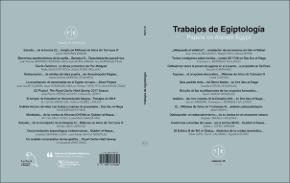Un análisis comparativo de los grafitis en la zona tebana: paisaje, ubicación e intencionalidad en los grafitis figurativos del C2 Project. The Royal Cache Wadi Survey
Autor
Vivas Sáinz, InmaculadaFecha
2019Resumen
La presente investigación es fundamentalmente un estudio preliminar de algunos de los grafitis más significativos del denominado wadi C2, en el marco del C2 Project. The Royal Cache Wadi Survey, y trata de esclarecer las motivaciones de la ubicación y concentración de grafitis en la zona, que podrían estar relacionadas con un posible carácter sagrado del wadi. A través del análisis de los grafitis del C2 ya publicados en la obra Graffiti de la Montaigne Thebaine y que están siendo revisados de nuevo, se muestran las tipologías de grafitis figurativos, así como de aquellas figuras asociadas a textos que podrían ser resultado de una adición posterior. El estudio de los grafitis se plantea con un enfoque comparativo, examinando los grafitis hallados en el wadi C2 en relación con el paisaje y con la existencia de grafitis anteriores o contemporáneos, y poniéndolos en relación con los encontrados en las tumbas privadas de la montaña tebana, analizados en los trabajos de Alexis Den Doncker o de Chloé C.D. Ragazzoli. El análisis de un grafiti singular con una escena de caza (grafiti 3652) servirá de estudio de caso para entender la recepción del arte de las tumbas del Reino Nuevo y su plasmación en las paredes de la montaña tebana. Con todo ello trataremos de dar respuesta a la presencia de un corpus significativo de grafitis en el C2 en un entorno inhóspito, pero quizás dotado de un carácter sagrado donde pudo haber tenido lugar algún tipo de culto. La existencia de estos grafitis, evidencias de actividad humana en el wadi, puede ser entendida como un ejemplo de “apropiación del espacio”, un deseo de dejar huella en el lugar, ya fuera mediante un texto o un dibujo. The current research is mainly a preliminary study of some of the most significant graffiti located in the wadi C2, in the context of the ongoing investigation of the C2 Project. The Royal Cache Wadi Survey, and tries to clear out the motivations behind the location and concentration of graffiti in the area, probably related to the sacred character of the place. Through the analysis of C2 graffiti published in the work Graffiti de la Montaigne Thebaine, which are being revised in depth, the types of figurative graffiti are established, as well as those figures connected to specific textual graffiti, maybe later additions. The study of the figurative graffiti follows a comparative approach considering them in connection to the landscape and to contemporary and older graffiti in the wadi, and relating them with the presence of graffiti in Theban tombs, which have been analysed by Alexis Den Doncker and Chloé C.D. Ragazzoli. The analysis of an interesting graffito with a hunt in the desert scene (graffito 3652) will be a case-study to understand the reception of the funerary art of the New Kingdom and its transference into the rocky wall of the Theban mountains. In all, we will try to explain the presence of a significant corpus of graffito recorded in the wadi C2, within an inhospitable environment but that maybe had a sacred character linked to a religious cult. The existence of this type of human activity, graffiti, could be understood as an example of ‘space appropriation’, an intention to leave a mark on the site by creating a text or just making a drawing.





